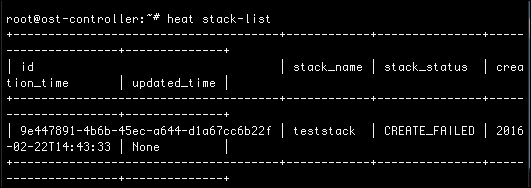Once you have confirmed that the heat-api and heat-engine processes are running as expected, and your authentication credentials are correct in Keystone and the heat.conf file, you should be able to start creating stacks. The details on how to create a Heat stack are beyond the scope of this book; however, once you have created a stack, you can check its progress by running the heat stack-list command. The output of the column titled stack_status will indicate whether or not the stack has been successfully launched. If, for some reason, your stack does not get completed successfully, stack_status will be equal to CREATE_FAILED, as demonstrated in the following screenshot:

If you have a failed stack, you can begin to troubleshoot the failure using the event-list command of heat. This command will output the steps heat has followed to create the stack and any errors heat encountered in the process.




